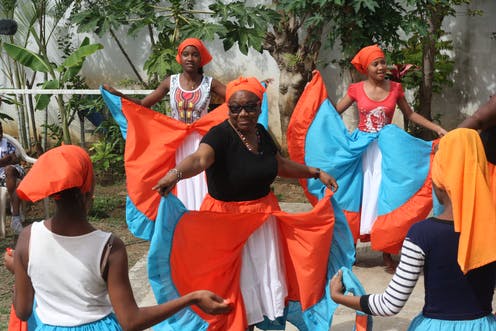When Olivier Bancoult, Liseby Elysé, Suzelle Baptiste, Rosemonde Bertin and Marcel Humbert set off on the Bleu de Nîmes for the Chagos archipelago in February 2022, it marked the first time exiled Chagos Islanders had returned without UK officials. On the surface, the expedition was both scientific (to survey Blenheim Reef) and political (the Mauritian flag was symbolically hoisted).
Mauritian officials had carefully orchestrated the trip to highlight three key disputes: the maritime border between Mauritius and Maldives; the UK’s ongoing colonial administration of Chagos; and the feasibility of resettlement. For the Chagossians, however, it was an emotional trip home.
News footage showed them kneeling on the sand and coming together in prayer as soon as they disembarked in the Peros Banhos atoll. Later, they removed coconuts from the floor of the now roofless church and again prayed together.
They laid flowers on their ancestors’ graves, cleared overgrown vegetation, moved a stone monument commemorating a previous visit and installed a cross to commemorate this visit. They danced on the beach. They sang. And on their return to Mauritius, members of the Chagos Refugees Group gathered to feast on fish they brought from the islands.
Over two decades, I have conducted research with Chagossian communities in Mauritius and the UK. In the context of forced displacement, protracted dislocation and geographical dispersal, these communities – though chronically marginalised and fractured – continue to pass on vital knowledge of their homeland through music, cuisine and language.
Forcible disruption
When the UK government depopulated the Chagos archipelago in the late 1960s and early 1970s, thereby creating the British Indian Ocean Territory, about 1,500 people were forcibly displaced to Mauritius or Seychelles. Because they could take only very few belongings with them, the community has lost – or rather, has been denied access to – the kind of objects, monuments, buildings and sites that often connect people to places.
In the absence of such tangible cultural heritage, intangible cultural heritage processes can prove crucial in maintaining that connection. For Chagossians, their coconut-based cuisine, their Kreol language and their sega tambour music are this link.
Today, however, only one third, roughly, of the exiled Islanders, are still alive. Given that they alone retain that cultural knowledge, the wider Chagossian community is rightly concerned that it will be lost as they pass away.
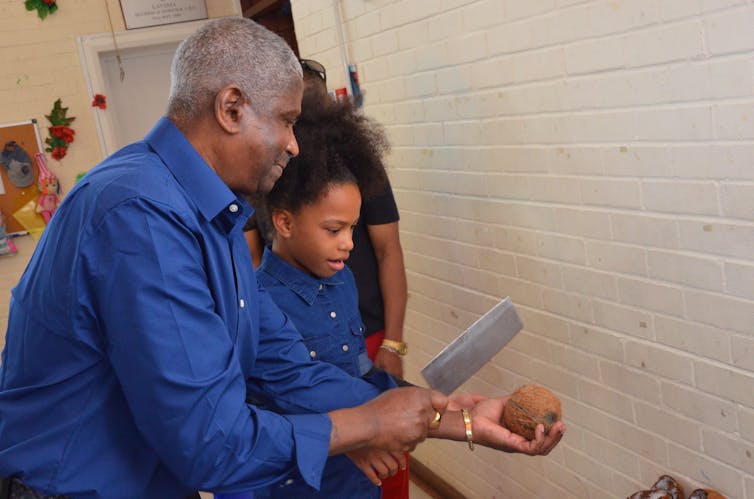
University of Edinburgh, Author provided
My research shows that the loss of Chagossian cultural heritage is the direct result of historical injustices and ongoing marginalisation. The British government’s forcible removal disrupted the processes by which cultures change over time.
Distinctions between Chagossian and other Creole cultures have become central to the Chagossian community’s struggle for their right of return. On the one hand, they must emphasise the endurance and distinctiveness of their culture with regards to their Mauritian or Seychellois counterparts. As one Chagossian elder told me,
We have our own culture, they took us from our islands, but we have kept our culture.
On the other hand, to show that they are victims worthy of recompense, they must emphasise the cultural losses and fragmentation that they have suffered. Another Chagossian elder put it plainly:
Our culture that we had on the islands is dying out.
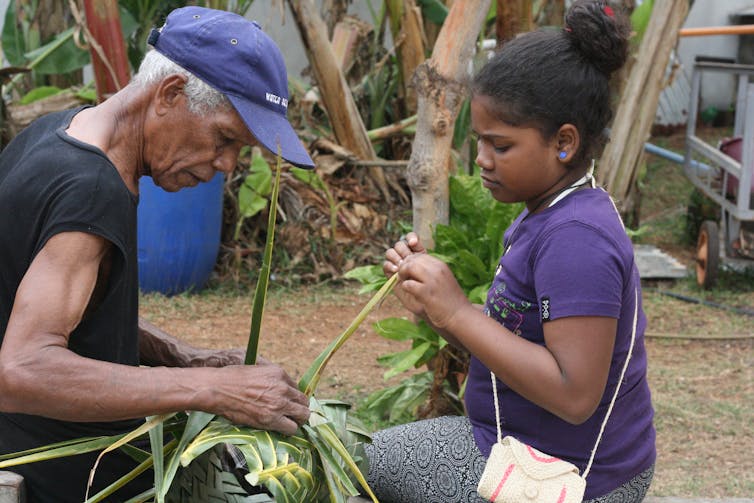
University of Edinburgh, Author provided
Transmitting knowledge
Between 2017 and 2018, in collaboration with the Chagos Refugees Group and other partners in Mauritius and the UK, I led a community engagement project aiming to address this injustice. The idea was to support displaced Chagossians to valorise and preserve their intangible cultural heritage. At workshops coordinated by Olivier Bancoult and his team in Mauritius and by Sabrina Jean and her team in the UK, elders shared their knowledge of medicinal plants, coconut preparation, coconut handicrafts, coconut-based cuisine, musical instruments and song and dance with the younger generations.
We showed the photographs, films and artefacts resulting from these workshops in subsequent exhibitions in Mauritius, Réunion and the UK. Photographs, films and recipes are also accessible on our open-access digital archive.
People told us they took part because they wanted to teach or to learn from others about their culture. Over three-quarters of participants said they had gained new skills, as well as a deeper knowledge of Chagossian history, identity and traditions. Almost all said they wanted to share this knowledge with others.
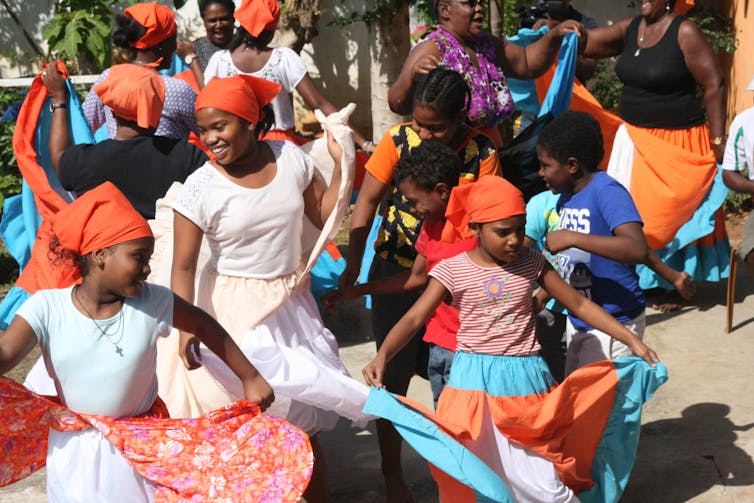
University of Edinburgh, Author provided
Chagos-born islanders told us they were pleased to have an opportunity to “learn things that I have lost during my childhood”, to “rediscover my little island”, or to “share our culture, our traditions with others and with our future generations”.
Younger participants reported learning about the Chagossian “way of living”, “way of sharing” and “team spirit”. Several said the project had taught them about the differences between Chagossian and other Indian Ocean cultures.
Participants highlighted learning about Chagossian sega. This syncretic Indian Ocean musical genre emerged on the colonial plantations of the 17th and 18th centuries. It came about through encounters between enslaved labourers with diverse ancestral origins, who played music, danced and sang lamentation and protest songs to resist their everyday hardship and domination.
Our project supported the production of a new album of Chagossian sega tambour music, which was subsequently made available on the Air Mauritius inflight entertainment system. Its associated music videos have reached over a cumulative quarter of a million views on YouTube.
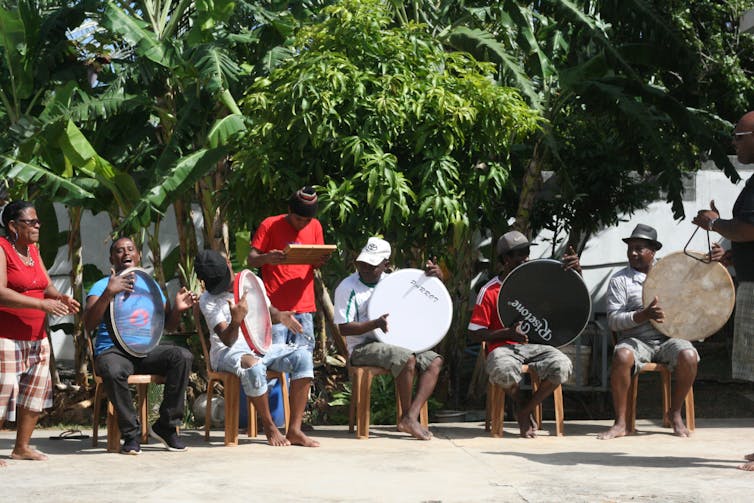
University of Edinburgh, Author provided
Several Indian Ocean island states have successfully nominated sega and cognate musical genres to be officially listed by Unesco as intangible cultural heritage. My research was included in the Mauritian government’s nomination for Chagos tambour music to be listed as intangible cultural heritage in need of urgent safeguarding. The nomination was successful and it resulted in a sega tambour school being opened in Mauritius.
Displaced Chagossians consider their heritage to be neither static nor homogeneous. Drummers will sometimes use synthetic rather than animal-skin tambour drums. For them, demonstrating authentic drumming techniques and rhythms is more important than using instruments made with traditional materials. They are concerned less about the “authenticity” of cultural objects than about their utility as tools for transmitting valued heritage.
![]()
This work was supported by the UK Economic and Social Research Council (ESRC) and the UK Arts and Humanities Research Council (AHRC). Rebecca Rotter was Co-Investigator on the AHRC project CHAGOS: Cultural Heritage Across Generations.











